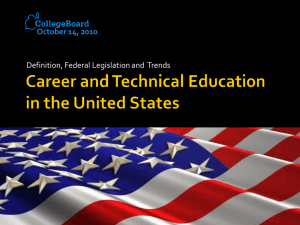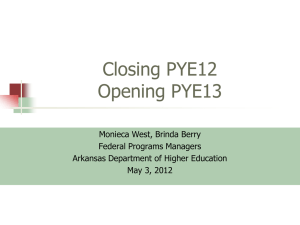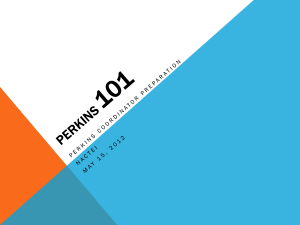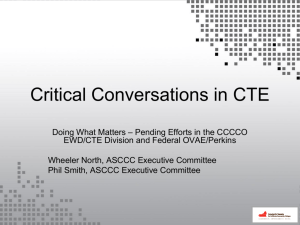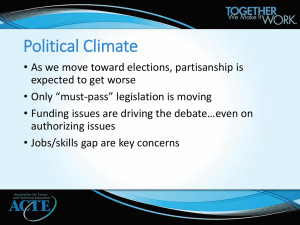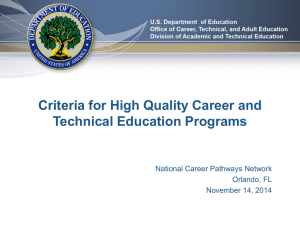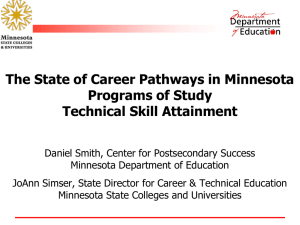Legislation Impact
advertisement
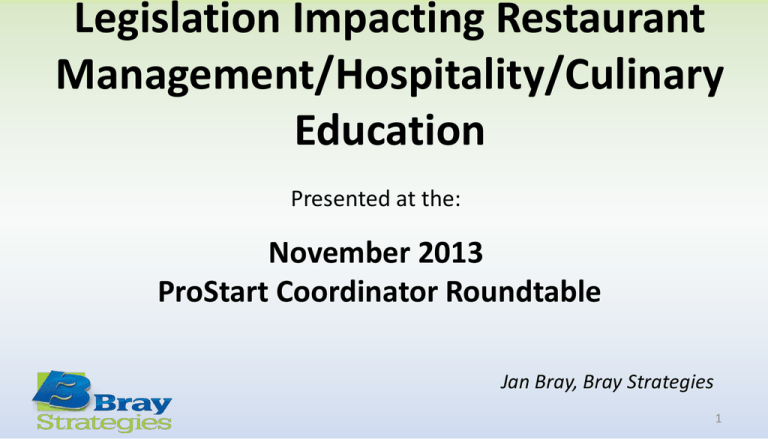
Legislation Impacting Restaurant Management/Hospitality/Culinary Education Presented at the: November 2013 ProStart Coordinator Roundtable Jan Bray, Bray Strategies 1 CONNECTING THE FEDERAL DOTS 2 Bad News & Good News • No real convergence in federal policy • Legislation remains siloed • Hard for Congress to deal with more than one issue at a time BUT… • There are some connections • Conversations increasing to link education and workforce development policy KEY LEGISLATION • Carl D. Perkins Act – supports a career and technical education system; funding is delivered to support programs • Workforce Investment Act – supports a workforce investment system; funding is delivered to individuals • Elementary & Secondary Education Act – supports an elementary and secondary education system; funding is primarily delivered to elementary education 4 KEY LEGISLATION • Higher Education Act - governs the administration of federal higher education programs; focuses on strengthening the educational resources and provides financial assistance for students; $50 billion in loans, grants, work-study and institutional aid in support of postsecondary education. • Individuals with Disabilities Act - Ensures all students with disabilities have access to a free appropriate public education in the least restrictive environment, emphasizing special education and related services designed to meet their needs and prepare students for employment and independent living 5 Common Basic Definitions • Several linkages in definitions in Perkins and IDEA (ex. charter schools, LEA, disability) • “Core Academic Subjects” - English, math, reading/language arts, foreign languages, civics and government, economics, history and geography • Content materials, which include incorporation of core academic subjects to CTE programs and Individualized Learning Plans • Professional Development • Funding Eligibility Funding Overlaps • Perkins funds can be used for Individualized Education Plans. • IDEA funding can be used for school wide projects. • Perkins funds can be used for WIA youth, adult and dislocated worker programs • Numerous programs within NCLB can be used to support CTE Collaboration • Some alignment of goals and accountability among education laws (although more is needed) • Non duplication clause for Perkins and WIA • Required partnerships of Perkins programs with “one-stop” delivery systems and state workforce investment boards Carl D. Perkins Career and Technical Education Act • Last authorized in 2006 • Authorizes career and technical education programs at the secondary and postsecondary levels • Scheduled for reauthorization in 2013 Key Themes of Current Legislation • Accountability for results at state and local level • Increased coordination within the CTE system • More academic and technical education integration • Increased connections between secondary and postsecondary education • Stronger program linkages to business and industry Perkins CTE Act Reauthorization • Current version of the law will officially expire in summer 2013 • Unclear when Congress will begin reauthorization process in earnest (although one hearing has been held in the House) ACTE Perkins Principles • • • • • • Redefine the Federal Role in CTE Target Expenditures Define Program Quality Elements Ensure Relevant & Consistent Data Offer Incentives for Innovation Provide the Infrastructure to Support the System 12 OVAE Perkins Blueprint • The Obama Administration’s plan for the reauthorization of Perkins • Only an outline; not reflected in any current legislation • Titled “Investing in America's Future: A Blueprint for Transforming Career and Technical Education” • Four key themes: - Alignment - Collaboration - Accountability - Innovation OVAE Perkins Blueprint Concerns arise with specific details of theme implementation: – Competitive grants – Mandatory secondary-postsecondary consortia – Funding limited to high-growth career areas identified at state level – State grant funding redirected to national Innovation Fund – Private sector match – State conditions to receive funding State Level Perkins Primary responsibility-State CTE Director Contact Info – www.careertech.org Connecting: One-on-One Meetings ACTE State Association Meetings State Five-Year Program Plans 15 State Level Perkins Key factors Programs of Study Labor Market Data Industry Alignment Industry Engagement Funding Levels Industry Recognized Credentials 16 Career Technical Student Organizations • More than 1.5 million student members • CTSOs specifically authorized in the Perkins Act and operate as national not-for-profit organizations divided into state associations and local school chapters. • In-school, co-curricular programs led by CTE teachers as advisers in middle schools, high schools and postsecondary institutions • Students participate in local, state, national and international career-based competitions designed to measure their academic understanding and skills development. • USDOE –via OVAE-recognizes CTSOs 17 • Business Professionals of America (BPA) • DECA • Family, Career and Community Leaders of America (FCCLA) • Future Business Leaders of America– Phi Beta Lambda (FBLA– PBL) • Future Educators Association (FEA) • Health Occupations Students of America (HOSA) • National FFA Organization (FFA) • National Young Farmer Educational Association (NYFEA) • National Postsecondary Agricultural Student (PAS) Organization • SkillsUSA • Technology Student Association (TSA) 18 Strategies for Engaging the education Community 19 Society Challenges 2010 to 2025 Up to 78 million Baby Boomers leave the U.S. workforce or change work focus Only 40 million Gen X’ers and Y’ers will be available to replace them 20 The Changing Workplace • By 2018 • need 22 million new college degrees • fall short by at least 3 million associate or better • need at least 4.7 million new workers with postsecondary certificates • 90% of the fastest-growing jobs will require an education beyond HS • 31% of small business owners can’t fill positions • 41% of manufacturers 21 Workforce Outlook • Health related and professional, scientific, and technical services will add more jobs than any other industry sector • Management, scientific and technical consulting will grow by 83 percent • Other growth sectors: administrative and support services, waste management and remediation services; educational services; restaurant/hospitality, arts, entertainment, and recreation source: Bureau of Labor Statistics Report, 2010-2011 22 Education Challenges Less time for CTE Disconnect – ed / work Common Core Teacher shortages Academic achievement focus College for all Education Rigid Funding 23 What industry needs Workers with Lifelong learning Multicultural Systems thinking / problem solving Ability to express one’s self Critical thinking 24 Hot Topics In Education • • • • • • • Dropout prevention and recovery STEM Effective teachers for all students Common Core Standards and Assessments 21st century skills/academic core balance Industry Standards and Certification Postsecondary Education- Adult Education Hot Topics in Education • Preparing students for future careers • All students must be “college-ready” and “career-ready” • Meet industry expectations; proven by assessments • Integration of academic, employability and technical skills Key Decision Makers • • • • • • Governors – political impact (Lazy Boy) Legislators – political/economic Business Leaders/Chambers of Commerce-revenue State/District Superintendents-accountability State CTE Director – accountability Teachers – time 27 What Can You do? • Impact Funding Decisions →Speak to your federal and state legislators about the importance of CTE and its relationship to your business or industry. • Promote the Image/Value of CTE → Talk about the importance of ProStart/CTE among anyone who will listenmedia, local chambers of commerce, PTAs and other “message disseminators” of influence. →Sharing that CTE leads to family-sustaining wages, that CTE careers offer advancement and increased opportunities, and that students can learn these skills in high school and community college will go a long way to helping the public understand what CTE is today. What Can You Do? • Create Relevancy →Share scope of jobs available and salary ranges with policymakers. →CTE programs have industry advisory councils where you can help influence and direct the training and education that is taking place. What has worked for you? RESOURCES • Industry Workforce Needs Council www.iwnc.org • National Association of State Directors of Career and Technical Education www.careertech.org • Association for Career and Technical Education www.acteonline.org • National Association of Workforce Boards www.nawb.org 30 Questions? 31 CONTACT INFORMATION Jan Bray Bray Strategies 703-628-0478 jbray@braystrategies.com www.braystrategies.com 32
